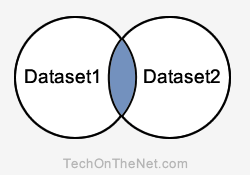This SQL tutorial explains how to use the SQL INTERSECT operator with syntax and examples.
Description
The SQL INTERSECT operator is used to return the results of 2 or more SELECT statements. However, it only returns the rows selected by all queries or data sets. If a record exists in one query and not in the other, it will be omitted from the INTERSECT results.
Intersect Query

Explanation: The INTERSECT query will return the records in the blue shaded area. These are the records that exist in both Dataset1 and Dataset2.
Each SQL statement within the SQL INTERSECT must have the same number of fields in the result sets with similar data types.
Syntax
The syntax for the INTERSECT operator in SQL is:
SELECT expression1, expression2, ... expression_n
FROM tables
[WHERE conditions]
INTERSECT
SELECT expression1, expression2, ... expression_n
FROM tables
[WHERE conditions];
Parameters or Arguments
expression1, expression2, expression_n
The columns or calculations that you wish to retrieve.
tables
The tables that you wish to retrieve records from. There must be at least one table listed in the FROM clause.
WHERE conditions
Optional. These are conditions that must be met for the records to be selected.
Note
- There must be same number of expressions in both SELECT statements.
- The corresponding expressions must have the same data type in the SELECT statements. For example: expression1 must be the same data type in both the first and second SELECT statement.
Example - With Single Expression
The following is a SQL INTERSECT operator example that has one field with the same data type:
SELECT supplier_id
FROM suppliers
INTERSECT
SELECT supplier_id
FROM orders;
In this SQL INTERSECT example, if a supplier_id appeared in both the suppliers and orders table, it would appear in your result set.
Now, let's complicate our example further by adding WHERE conditions to the INTERSECT query.
SELECT supplier_id
FROM suppliers
WHERE supplier_id > 78
INTERSECT
SELECT supplier_id
FROM orders
WHERE quantity <> 0;
In this example, the WHERE clauses have been added to each of the datasets. The first dataset has been filtered so that only records from the suppliers table where the supplier_id is greater than 78 are returned. The second dataset has been filtered so that only records from the orders table are returned where the quantity is not equal to 0.
Example - With Multiple Expressions
Next, let's look at an example of how to use the INTERSECT operator in SQL to return more than one column.
For example:
SELECT contact_id, last_name, first_name
FROM contacts
WHERE last_name <> 'Anderson'
INTERSECT
SELECT customer_id, last_name, first_name
FROM customers
WHERE customer_id < 50;
In this INTERSECT example, the query will return the records from the contacts table where the contact_id, last_name, and first_name values match the customer_id, last_name, and first_name value from the customers table.
There are WHERE conditions on each data set to further filter the results so that only records from the contacts are returned where the last_name is not Anderson. The records from the customers table are returned where the customer_id is less than 50.
Example - Using ORDER BY
The following is an INTERSECT example that uses a ORDER BY clause:
SELECT supplier_id, supplier_name
FROM suppliers
WHERE supplier_id > 2000
INTERSECT
SELECT company_id, company_name
FROM companies
WHERE company_id > 1000
ORDER BY 2;
Since the column names are different between the two SELECT statements, it is more advantageous to reference the columns in the ORDER BY clause by their position in the result set. In this example, we've sorted the results by supplier_name / company_name in ascending order, as denoted by the ORDER BY 2.
The supplier_name / company_name fields are in position #2 in the result set.





